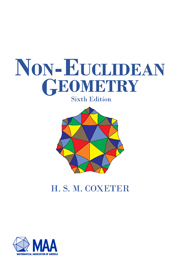Book contents
- Frontmatter
- PREFACE TO THE SIXTH EDITION
- Contents
- I THE HISTORICAL DEVELOPMENT OF NON-EUCLIDEAN GEOMETRY
- II REAL PROJECTIVE GEOMETRY: FOUNDATIONS
- III REAL PROJECTIVE GEOMETRY: POLARITIES, CONICS AND QUADRICS
- IV HOMOGENEOUS COORDINATES
- V ELLIPTIC GEOMETRY IN ONE DIMENSION
- VI ELLIPTIC GEOMETRY IN TWO DIMENSIONS
- VII ELLIPTIC GEOMETRY IN THREE DIMENSIONS
- VIII DESCRIPTIVE GEOMETRY
- IX EUCLIDEAN AND HYPERBOLIC GEOMETRY
- X HYPERBOLIC GEOMETRY IN TWO DIMENSIONS
- XI CIRCLES AND TRIANGLES
- XII THE USE OF A GENERAL TRIANGLE OF REFERENCE
- XIII AREA
- XIV EUCLIDEAN MODELS
- XV CONCLUDING REMARKS
- APPENDIX: ANGLES AND ARCS IN THE HYPERBOLIC PLANE
- BIBLIOGRAPHY
- INDEX
PREFACE TO THE SIXTH EDITION
- Frontmatter
- PREFACE TO THE SIXTH EDITION
- Contents
- I THE HISTORICAL DEVELOPMENT OF NON-EUCLIDEAN GEOMETRY
- II REAL PROJECTIVE GEOMETRY: FOUNDATIONS
- III REAL PROJECTIVE GEOMETRY: POLARITIES, CONICS AND QUADRICS
- IV HOMOGENEOUS COORDINATES
- V ELLIPTIC GEOMETRY IN ONE DIMENSION
- VI ELLIPTIC GEOMETRY IN TWO DIMENSIONS
- VII ELLIPTIC GEOMETRY IN THREE DIMENSIONS
- VIII DESCRIPTIVE GEOMETRY
- IX EUCLIDEAN AND HYPERBOLIC GEOMETRY
- X HYPERBOLIC GEOMETRY IN TWO DIMENSIONS
- XI CIRCLES AND TRIANGLES
- XII THE USE OF A GENERAL TRIANGLE OF REFERENCE
- XIII AREA
- XIV EUCLIDEAN MODELS
- XV CONCLUDING REMARKS
- APPENDIX: ANGLES AND ARCS IN THE HYPERBOLIC PLANE
- BIBLIOGRAPHY
- INDEX
Summary
I am grateful to the Mathematical Association of America for rescuing my book from oblivion by agreeing to publish this new edition. I particularly appreciate Elaine Pedreira's careful editing and advice.
I welcome the opportunity to correct FIG. 7.2A on page 133 and to make other small improvements and especially to add the new §15.9. That section contains, in particular, an ‘absolute’ sequence of circles (FIG. 15.9A) which involves a surprising application of Fibonacci numbers (15.94). For further discussion of inversive geometry, the reader may like to look at “The inversive plane and hyperbolic space,” Abhandlungen aus dem Mathematischen Seminar der Universität Hamburg, 28 (1965), pp. 217-242. The subject of §15.7 has been extended by E. B. Vinberg in his paper, “The volume of polyhedra on a sphere and in Lobachevsky space,” American Mathematical Society Translations (2), 148 (1991), pp. 15-27. Vinberg draws attention to W. P. Thurston, “Three-dimensional manifolds, Kleinian groups and hyperbolic geometry,” Bulletin of the American Mathematical Society, 6 (1986), pp. 357-382. When Hamlet exclaims (in Act II, Scene II) “I could be bounded in a nutshell, and count myself a king of infinite space,” he is providing a poetic anticipation of Poincaré's inversive model of the infinite hyperbolic plane, using a circular “nutshell” for the Absolute. In fact, the hyperbolic plane can be filled with infinitely many congruent equilateral triangles, seven at each vertex, to form the regular tessellation {3, 7}.
- Type
- Chapter
- Information
- Non-Euclidean Geometry , pp. ix - xiiPublisher: Mathematical Association of AmericaPrint publication year: 1998



